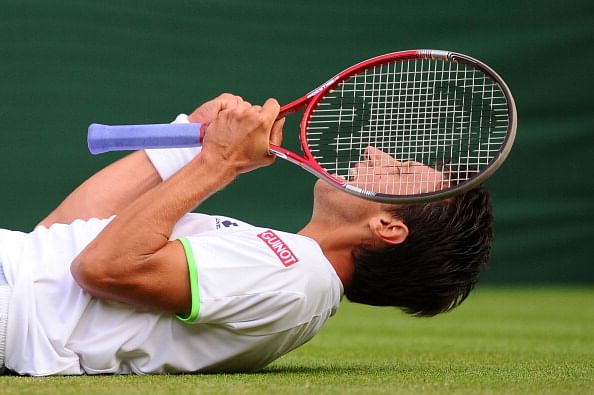
Return of a lost art: Joy of serve and volley

Sergiy Stakhovsky of Ukraine celebrates match point during his Gentlemen’s Singles second round match against Roger Federer of Switzerland on day three of the Wimbledon Lawn Tennis Championships at the All England Lawn Tennis and Croquet Club on June 26, 2013 in London
The sight was a familiar one. A gangly, all-white clad (there is no other option, is there?) player falls on to his back on Wimbledon Centre Court, clutching his head and nearly crying with joy. The difference was that this was not the second Sunday of the Championships fortnight. And of course, the other tiny discrepancy was that the man on the victorious side of the net was not Roger Federer.
On what was without a shadow of a doubt the craziest day in Wimbledon history, two former men’s singles champions and world number ones crashed and burned against opponents outside the top 100. Lleyton Hewitt was the first to go, going down 6-4 6-4 6-7 6-2 against qualifier Dustin Brown, who now represents Germany. And later, in arguably the greatest upset in the tournament’s history, Federer went down 6-7 7-6 7-5 7-6 against 116-ranked Sergiy Stakhovsky. For once, the game’s purists would have relished the Swiss master being knocked out despite all of his elegance, style and unbelievably effortless shot-making. For the real winner on the day was not Brown or Stakhovsky, it was that old, forgotten art of serve and volley.
The main (though not only) reason serve and volley has become a dying skill, disregarded by most but doubles exponents, is that the game has had to adapt itself to the requirements of television coverage. This meant that the courts (especially the faster surfaces such as grass) have become a lot slower and the tennis balls have become a lot heavier. While this makes it easier to spot the tennis ball on TV (of course the colour of the balls itself was changed to yellow for this purpose), it has also meant that there is just that extra fraction of a second longer for the opponent to get to and place his returns, effectively ruining the serve and volleyer.
It is difficult to say just how much success the likes of Boris Becker, Stefan Edberg and John McEnroe would have had in this day and age. Of course, exceptional talents like them would probably have done what Federer did and that is to adjust their game to live with the baseliners. But playing the serve and volley game, unless you had an exceptional serve like Pete Sampras, Goran Ivanisevic or Richard Krajicek, it would be next to impossible to be a major force today. Still, Brown and Stakhovsky did what most professional players, pundits and fans felt was no longer possible – defeat a premier returner of serve while playing delightful serve and volley.